|
A variety
of sensors from several manufacturers were used to measure current,
temperature, conductivity, light transmission, and pressure. These sensors were deployed
on a variety of platforms (see descriptions below and mooring log),
and the data were sampled (see summary of sampling schemes)
and recorded by various data logging systems.
Seafloor
Tripod Systems
(figures 13A,
13B,
13C,
13D,
13E,
and 13F)
USGS seafloor tripod systems provide a platform for
long-term deployment of instruments to measure currents and water properties, primarily near the sea floor.
At Site A, where measurements included currents 1 mab, temperature,
pressure, light transmission, and conductivity within 2 mab,
currents throughout the water column, sediment collection rate, and photographs of the seafloor, instruments
were deployed on a large tripod frame (figure 13A,
13B). At Site B, where measurements included
currents throughout the water column and near-bottom temperature and salinity, instruments were deployed
on a smaller frame (figure 13C). For the
Massachusetts Bay long-term observations the tripod systems are deployed for about 4 months and data
are recorded internally.
During the period 1989-2002, two data logging systems were used to obtain the near-bottom
observations at Site A. Between 1989 and 1991, a Data Logging Current Meter
(DLCM) system was used that measured current with two
Savonius rotors and a vane (similar to the VACM current
sensor). The DLCM recorded data on a pair of Sea Data tape
cassettes or to a hard disk using an Onset Computer Tattletale computer (Butman and Folger, 1979). The
DLCM tripod system recorded averages of rotor speed and
pressure every 7.5 minutes. Measurements of temperature and conductivity were made at the midpoint of the
averaging interval. The instrument also burst-sampled current speed, current direction, and pressure every
2 seconds for 72 seconds (180 seconds if recording on a Tattletale) at the center of each 7.5-minute
interval. When the DLCM data were processed, the burst
current measurements were vector-averaged to obtain current speed and direction, and the standard
deviation of the high-frequency pressure measurements, called
PSDEV, was computed as a measure of the bottom
pressure fluctuations caused by surface waves.
Between 1991 and 2001, near-bottom observations at Site A were made with a MIDAS system that measures
current with two BASS (Benthic Acoustic Stress Sensor)
4-axis acoustic current sensors (figure 13D,
13E) mounted nominally at 1.0 and 0.45
mab. Data were recorded using a Tattletale computer (Martini and Strahle, 1992). The MIDAS system recorded pressure and 4 velocity components from each BASS current sensors (Williams, 1985) at 1 hz.. Every 3.75 minutes, MIDAS computed cumulative sums of pressure and current, and recorded them, along with temperature, conductivity, and light transmission measured at the center of the 3.75-minute averaging interval. Average pressure and current were calculated during data processing.
BASS current meters are capable of resolving
0.03 cm/s currents; however, this requires a field
determination of the zero. Accuracy is affected by the capacitance of the long cables that connect
the data logger to the sensors and thus a new calibration must be obtained each time the data logger
and sensor wiring is attached to a tripod frame. An accuracy of 0.3 cm/s
can be achieved when the offsets generated by these capacitance changes are measured and removed
from the data. The BASS current meter voltages
were measured when there was no current through the measurement volume, and this 'zero' offset was
subtracted from measurements made during the deployment. A set of experiments were performed to
determine the most efficient method of calibrating the
BASS to 0.3 cm/s
accuracy (Morrison and others, 1993). A zero calibration for the
BASS current sensors was obtained with the sensors
mounted on the tripod system and connected to the MIDAS data logger prior to deployment and after recovery.
A water-tight jacket was fitted around the two BASS
sensors, filled with water, and data recorded for at least 12 hours to determine an offset under
no-flow conditions. | The following figures are in PDF format.
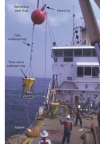
Figure 10
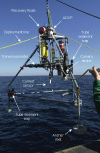
Figure 13A

Figure 13B
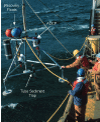
Figure 13C
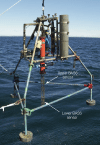
Figure 13D

Figure 13E
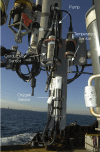
Figure 13F
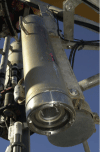
Figure 13G
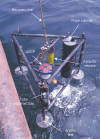
Figure 14
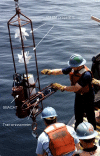
Figure 15

Figure 16
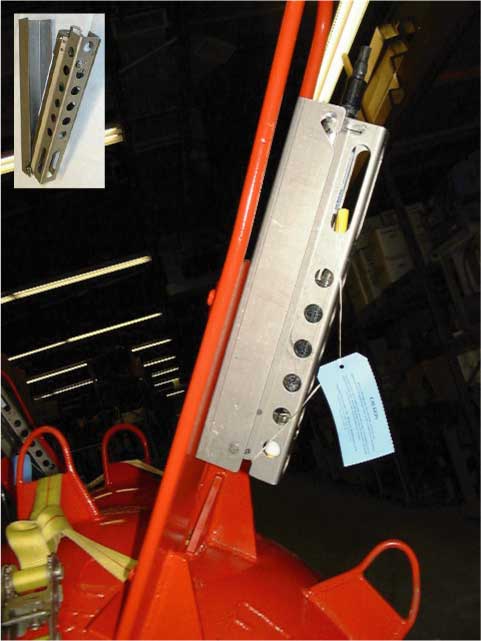
Figure 17
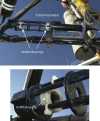
Figure 18
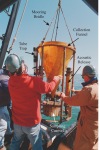
Figure 19
|
The MIDAS system measures conductivity using a Sea-Bird SBE-4 conductivity cell, the same sensors used
by Sea-Bird's SEACAT and MicroCAT data loggers described below (figure 13F).
On stationary near-bottom platforms such as the tripod, sediment can collect in the conductivity cell and
bias the measurement. In the middle 1990's, this was suspected as the cause of a consistent freshening
trend over the course of a deployment observed in the bottom tripod conductivity data. Sea-Bird pumps
were added to the MIDAS to flush the conductivity cell prior to making a measurement.
Camera
(figure 13G)
A 35-mm Benthos camera system
was mounted on the tripod frame approximately 2 m
above the bottom (figure
13G) and programmed to take a single photograph of the sea floor every
4 hours. The field of view of the downward-looking camera was approximately
1 m by 1.5 m.
The photographs are not included in this data report. See Butman and others 2004a, 2004b, and 2004c for photographs presented as a time-lapse movie.
Acoustic Doppler Current Profiler (ADCP)
(figure 14)
RD Instruments' ADCP's
(300 Khz Workhorse) were deployed at
Site A (beginning in 1994) and Site
B (beginning in 1997) to obtain profiles of currents throughout the water
column. The instruments measure currents from the doppler shift of sound
reflected from the water column from two pairs of orthogonal acoustic
beams (figure 14).
The instruments recorded 5-minute averages of current every 15 minutes.
To obtain an accuracy of at least 0.4 cm/s
for each 5-minute measurement,
300 pings emitted at a rate of 1 ping per second were averaged together.
A good primer on the doppler current measurement technique may be found
in Gordon (1996). At Site A, the ADCP
was initially
deployed on a small tripod frame (figure
13C) between 1994 and 1996, then on the large frame beginning in 1996.
At Site B, the ADCP
was deployed on several versions
of a small tripod frame (figure
13C).
Vector-Measuring Current Meter (VMCM)
(figure 15)
Vector-measuring current meters
(Weller and Davis, 1980) were used to measure temperature and velocity
at a sampling interval of 3.75 minutes (
figure 15). At the long-term station,
VMCM's were maintained
on subsurface moorings at a depth of 10 mab
(nominally 23 m).
VMCM's
were also suspended from the 40-ft discus buoy, at a depth of
5 m below
the surface, from December 1989 until February 1994 when the buoy was
discontinued. VMCM's use
orthogonal bidirectional propellers
and were configured to sample the currents every 0.25 seconds and vector-average
internally to calculate averages at the sampling interval of 3.75 minutes.
These samples were recorded on 1/4" cassette tapes by Sea Data recorders. SEACAT (figure 16)
SEACAT 16 (http://www.seabird.com/)
measure conductivity and temperature, and record the voltage signals produced
by a transmissometer. SEACAT's were operated with a sampling interval
of 3.75 minutes. SEACAT's were attached to the
VMCM's
that were maintained on subsurface moorings at a depth of 10
mab (nominally
23 m), as well as to the
VMCM's that were suspended
below from the 40-ft USCG discus buoy, at a depth of
5 m below the surface, from December 1989 until February 1996.
Concern
that the SEACAT batteries might be disturbing the
VMCM
compasses caused a change in mooring design in February 1998, with the
SEACAT's attached to the moorings immediately above the VMCM
at a depth of 11 mab.
MicroCAT
(figure 17)
The MicroCAT was introduced
by Sea-Bird as a lower cost, simpler version of the SEACAT 16. The MicroCAT
uses the same sensor technology as the SEACAT to collect salinity and
temperature data but cannot record data from additional external sensors
such as transmissometers. MicroCAT's were used to obtain temperature and
salinity measurements where turbidity measurements were not needed. The
smaller physical size of the MicroCAT enabled these instruments to be
installed on the top floats of the subsurface moorings at Site A and Site
B. The recording interval was matched to the other instrumentation, typically
every 3.75 minutes.
Transmissometer
(figure 18)
Sea Tech transmissometers
measure the transmission of red light (at a wavelength 650 nm) from a
Light Emitting Diode (LED) along a 25-
cm water path.
The voltage output by a photovoltaic detector was recorded by a SEACAT
or by a tripod system. Biological fouling of the transmissometer windows
often limited the usefulness of the observations. From October 1992 to
October 1994, tests of antifouling rings fitted around transmissometer
windows showed some reduction in biological fouling (Strahle and others,1994).
Antifouling rings have been used on all transmissometers since 1994.
Sediment Traps
Time-series sediment traps
(figure 10;
figure
19)
A time-series sediment trap
(model MK 78HW-13) is manufactured by Mclane Research
Laboratories, Inc., East Falmouth, Mass. The function and design of the
instrument is described by Honjo and others (1988). It consists of a polyethylene
funnel 106 cm long with an 80-cm-diameter
mouth. The open end of the funnel
is fitted with a honeycomb-shaped baffle made of polycarbonate hexagonal
cells 3.2 cm in diameter and 7.5
cm long. Covering the baffle is a polyethylene
screen (1 cm mesh). The purpose of the baffle
and mesh is to reduce turbulence
and resuspension in the funnel and to keep out fish and other organisms
that are known to take up residence in open traps. Excluding macrofauna
from the trap minimizes their direct contribution of excretion products
to the sample.
The funnel directs falling
particulate matter into one of thirteen 500-ml
plastic bottles which are
threaded into a rotating plate under the funnel. Each bottle is advanced
to the sampling position under the funnel on a selectable schedule assigned
using an internal Tattleatale 8 computer. The sampling interval for each
bottle is typically about 10 days for a 4-month deployment. Samples are
sealed except for the period they are under the funnel. To reduce the
decomposition of organic matter in the period between collection and analysis,
each bottle is filled with a solution of 5% sodium azide (NaN3)
in filtered seawater before deployment. The higher salinity (and density)
of the azide solution compared to ambient seawater significantly reduces
its diffusion out of the trap during the 4-month collection period.
Although this trap was originally
designed for long deployments in the open ocean, the size of the funnel
mouth and the bottle volume are appropriate for 4-month deployments at
4.5 m above bottom in this coastal setting (water depth 30
m). Typically,
there is a measurable amount of sediment in each bottle, even during quiet
periods in summer when resuspension events are infrequent. Occasionally,
during an unusually strong storm, the magnitude of sediment resuspension
is so great that a sampling bottle overfills and sediments accumulate
in and plug the throat of the funnel. Under these conditions the remaining
bottles are empty when the trap is recovered. A digital image of the bottles
from each deployment was taken in order to visually show the changes in
collection rate during the deployment period. This information is not
included in this report but is available on request.
Tube sediment traps
(figure 10;
figure
19)
Traps made simply from standard
core tubing were also used on the USGS
moorings in
order to provide samples at multiple levels in the water column. These
traps consist of 60-cm-long polybutyrate tube
with a 6.6-cm internal diameter
and a wall thickness of 3.2 mm. The bottom of
the tube was sealed with
a securely taped plastic cap. Baffles consisted of an aramid fiber/phenolic
resin honeycomb (trade name: Hexcell) with a cell diameter of 1 cm and
a length of 7.5 cm. The material showed no apparent deterioration during
exposure to seawater, although it is subject to biofouling. The tube traps
are inexpensive to construct and are easily attached to other instruments
or to the mooring wire with black electrical tape.
To accommodate different chemical
analyses of the trap samples, different preservative solutions were used
with little impact on the collection rate. Most traps were filled to within
7.5 cm of the top with a filtered solution
of 5% sodium azide in seawater.
Some traps at the same location and depth had no preservative, and others
were filled with a filtered solution of seawater, 2% buffered formalin
with an additional 35 g/kg
NaCl. The average standard deviation
of trapping rate for the three conditions (azide, formalin, and no poison)
was 5% of the mean value. This indicates that the different density gradients
in the traps below the Hexcell baffle had little effect on the trapping
dynamics of the tube traps.
Trapping efficiency is a factor
that must be considered if the results from the tube traps and the time-series
traps are compared. A number of studies have discussed the dependence
of aspect ratio (height/width), shape, tilt, Reynolds number (UD/k, where
U = horizontal fluid velocity, D = trap diameter, and k = kinematic fluid
viscosity) and other factors (Butman, 1986; Gardner, 1980, 1986). In this
study, a comparison of relative trap efficiency has been determined during
a number of field experiments by simply comparing the collection rates
in the time-series traps with tube traps fixed at the same location and
depth. A summary of the data since 1989 indicates that time-series traps
collect at a rate lower than tube traps by a factor of 0.28 +/-0.11. This
difference is consistent with a comparison of efficiency between tube
traps and funnels up to 50 cm in diameter conducted on the edge of the
continental shelf (Bothner and others, 1988).
|



